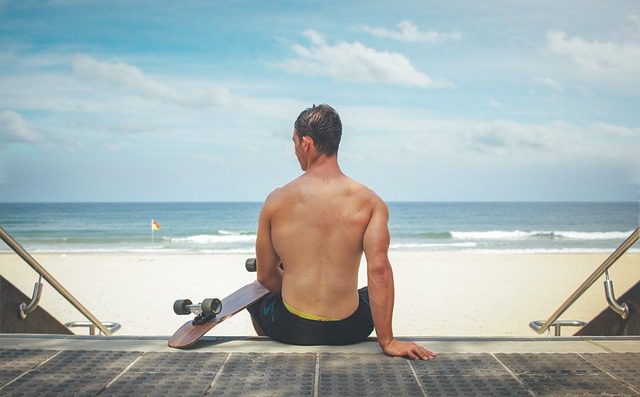Top 5 Ways to Get Fit for Summer and Look Your Best
Take off your clothes and look in the mirror. I know, it’s weird to hear someone say that but go with me on this one – I promise it won’t be weird. What do you see? How does your physique make you feel at this very moment? Now think about being in a bathing suit in a month. Worried? If so, it’s time to put your head down and get to work. All those extra meals and desserts over the winter months and holidays surely didn’t help you. But don’t get all depressed and down on yourself – you still have a little time but you need to act now. To help put you in the best position to shed off that excess bulge, here are five effective ways to get fit for summer.
Table of contents
Disclaimer: This article is for informational purposes only and is not meant to treat or diagnose any condition. It is recommended that you speak with your doctor before starting any exercise program, changing your daily nutrition, or adding any supplements to your regimen.

Why Does Everyone Want to Get Fit for Summer?
The desire to get fit for summer is a common phenomenon driven by a combination of social, cultural, and personal factors. Here are some reasons why many people feel motivated to get in shape for the summer:
- Beach Season and Swimwear:
- Summer often means spending more time at the beach or pool, where people may be more exposed in swimwear. This can lead to a desire to look and feel more confident in one’s body.
- Seasonal Clothing:
- Summer fashion tends to be lighter and more revealing, with shorts, tank tops, and dresses being popular choices. People may want to feel comfortable and confident in these types of clothing.
- Outdoor Activities:
- Summer offers more opportunities for outdoor activities such as hiking, biking, swimming, and sports. Being physically fit can enhance one’s enjoyment and performance in these activities.
- Vitamin D and Sunshine:
- With longer days and more sunshine, people are generally more active during the summer. Increased physical activity, combined with exposure to sunlight, can have positive effects on mood and well-being.
- Social Events and Gatherings:
- Summer is a time for socializing, barbecues, and gatherings. Many people want to look and feel their best when attending events with friends and family.
- Health and Wellness Goals:
- New Year’s resolutions and fitness goals often align with the beginning of the year, but the impending arrival of summer can serve as a mid-year checkpoint, motivating individuals to reassess and work towards their health and wellness goals.
- Cultural Pressure:
- Societal norms and media often emphasize the “ideal” summer body, creating a cultural expectation for people to strive for a certain level of fitness during this season.
- Boost in Energy and Mood:
- Exercise releases endorphins, which can improve mood and energy levels. With the warmer weather and longer days, individuals may feel more motivated to engage in physical activity, contributing to overall well-being.
- Opportunity for a Fresh Start:
- The changing of seasons, especially the transition to summer, can symbolize a fresh start for many. This can inspire individuals to adopt healthier habits and make positive lifestyle changes.

It’s important to note that while the desire to get fit for summer can serve as a motivating factor, promoting a year-round commitment to a healthy lifestyle is crucial for long-term well-being. Setting realistic and sustainable fitness goals that extend beyond the summer season is key to achieving and maintaining overall health and fitness.
Why Do Most People Fail When Trying to Get Fit for Summer?
While many individuals successfully achieve their fitness goals, it’s true that some people may struggle or fail in their attempts to get fit for summer. Several common reasons contribute to these challenges:
- Unrealistic Expectations:
- Setting overly ambitious or unrealistic goals can lead to frustration and disappointment. Rapid transformations are often unsustainable and can contribute to feelings of failure.
- Lack of Consistency:
- Consistency is crucial for fitness success. Some individuals may start strong but struggle to maintain a regular exercise routine or adhere to a healthy diet consistently.
- Quick Fixes and Fad Diets:
- The pursuit of rapid results through crash diets or extreme exercise regimens is often unsustainable and can be detrimental to long-term health. Fad diets and quick fixes rarely lead to lasting changes.
- Lack of Planning:
- Without a well-structured plan, individuals may find it challenging to stay on track. Planning includes both exercise routines and meal preparation, and without it, people may resort to unhealthy choices or skip workouts.
- Overemphasis on Appearance:
- Focusing solely on achieving a specific appearance for summer can lead to neglecting overall health and well-being. Prioritizing aesthetics over holistic health may result in unhealthy habits.
- Lack of Social Support:
- Having a supportive network can significantly impact success. Without encouragement from friends, family, or a fitness community, individuals may struggle to stay motivated.
- Lack of Education:
- Some people fail because they lack knowledge about proper exercise techniques, nutrition, and sustainable lifestyle changes. Educating oneself about these aspects is crucial for long-term success.
- Impatience:
- Fitness is a gradual process, and impatience can lead to frustration and quitting prematurely. It’s essential to understand that sustainable results take time.
- All-or-Nothing Mentality:
- Adopting an all-or-nothing mentality can be detrimental. Small setbacks or deviations from the plan may cause individuals to abandon their fitness efforts altogether.
- Failure to Address Underlying Issues:
- Emotional or psychological factors, such as stress, anxiety, or body image issues, can impact one’s ability to stick to a fitness routine. Addressing these underlying issues is crucial for long-term success.
- Not Enjoying the Process:
- If exercise is seen as a chore rather than an enjoyable activity, individuals may struggle to maintain motivation. Finding activities that bring joy can make the fitness journey more sustainable.

To overcome these challenges, it’s important to set realistic and achievable goals, focus on long-term health rather than quick fixes, seek support, educate oneself, and adopt a balanced and sustainable approach to fitness. Working with fitness professionals, such as personal trainers or nutritionists, can also provide guidance and support in creating a realistic and effective plan.
Do You Want to Get Fit for Summer? Try These Tips!
If your goal is to get fit for summer, utilize the tips and strategies below to help look your best this year.
1. Lower Your Calories
I feel as though we need to start off with this one because ultimately your nutrition will make or break your results. You can’t out-train a poor diet, so let’s get things under control right from the beginning. You need to put yourself in a caloric deficit. What that means is, you need to consume fewer calories than maintenance in order to see the number on the scale decrease.
Related Article: Summer Weight Loss Food Swap — Eat This, Not That
If you are consuming 2,500 calories as maintenance and not gaining or losing any weight, reduce that number by 250-500 calories per day. A 500-calorie reduction will have you lose around one pound of weight per week and a 250-calorie reduction will have you lose a half pound each week. You could always start off at 250 and after a week or two bump it up to 500 if you aren’t seeing any results. This is a great first step to help you get fit for summer.

2. Play with Your Macro Ratios
3. Increase Your Cardio
You might be asking, “What’s cardio?” And you’re not alone. Winter months are generally when everyone puts cardio on the back burner and focuses on adding quality lean muscle mass. Unfortunately, many tend to put on some body fat with that new lean muscle. With that being said, we are now in crunch mode to get fit for summer and need to introduce it back in or even increase the duration of cardio you were currently doing to help burn off stubborn body fat and create that lean physique you can be proud of when you take your shirt off.
As a starting point, I’d recommend striving for 30 minutes of cardio five days a week. This combined with a reduction in your overall calories will make it fairly easy to see the change on the scale and in the mirror. Make sure you continue to hit the weights hard during this time. You want to maintain as much lean muscle mass as possible to help keep your metabolism revving.
Click here to continue reading…


*Disclosure: This article may contain affiliate links or ads, which means we earn a small commission at no extra cost to you if you make a purchase through these links. These commissions help support the operation and maintenance of our website, allowing us to continue producing free valuable content. Your support is genuinely appreciated, whether you choose to use our links or not. Thank you for being a part of our community and enjoying our content.
PLEASE CONSIDER SHARING THIS ON YOUR SOCIAL MEDIA TO HELP OTHERS LEARN MORE ABOUT THIS TOPIC.





